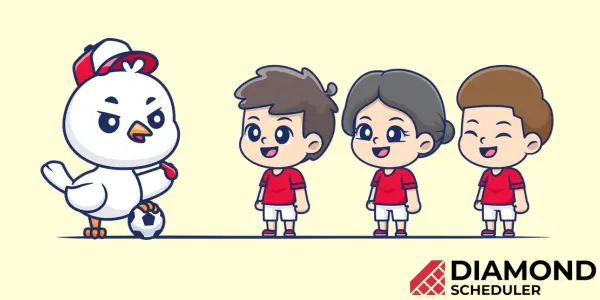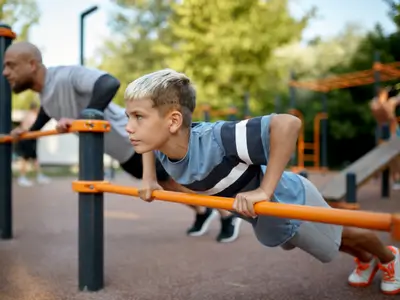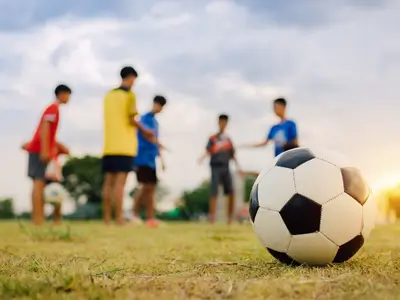
Training Youth Athletes: The Ultimate Guide for 2024
Training youth athletes in strength and conditioning is vital to improve overall fitness and to reduce the risk of injury.
Not only does strength and conditioning training improve athletic performance, but it also prepares and educates young athletes about the importance of fitness and leading a healthy lifestyle.
There are many myths and misconceptions about the approach and safety of youth training—specifically in regard to strength or resistance training—that are misguided and create a false stigma around the idea.
Young athletes are starting weight training at an earlier age and it is the coaches' and trainers' responsibility to guide them along the way.
Over the last several decades, sports conditioning and personal training have grown immensely.
The importance of improving overall physical fitness has surpassed the idea of only working on sport-specific drills that mimic in-game movement patterns.
This new type of conditioning has allowed youth athletes to be well-equipped for any sport with training in reaction time, overall strength, and speed while minimizing overuse syndrome and preventing more injuries.
If you’re a coach in competitive sports, it's important to familiarize yourself with how to train your youth athletes in an effective way.
In this comprehensive guide, we will go over the most important aspects of training young athletes as well as some helpful tips for coaches on how to work these training sessions into their schedules.
What are some common misconceptions about youth training?

There are many misconceptions that have been dismissed by scientific research that still loom as misconceived fears and stigmas throughout parent circles and much of the general public.
Most of these misconceptions are centered around strength training.
One of those misconceptions is that strength training can damage growth plates and bones in young athletes, leading to stunted growth.
This idea was proven to be unsupported when training is done in proper form with moderation.
This belief has asserted that weight training can cause the epiphyseal plate, which promotes growth, to close and stunt growth.
In fact, the opposite is true, and the epiphyseal plate requires activity and some amount of stress to grow healthily.
The closing of the plate is normal over the transition from childhood to adulthood.
Injury to growth plates can occur; however, these injuries are widely associated with improper technique and weight.
When strength training is performed at a controlled and moderate level of intensity, there is no evidence that growth is affected in young athletes.
Professional trainers are—and should be—highly aware of limitations and the proper forms of workouts to prevent these issues.
They also implement recovery periods and schedule sessions around certain muscle groups so as to minimize the risk of aggravation and prevent injury.
That said, strength training does apply force to youth athletes' bones and joints, but not nearly as much as common movements or impact in most sports.
Movements such as sharp turns, landing from a high jump, or making contact with other players or balls all have a greater impact.
When youth athletes prepare their bodies for these types of scenarios through strength and resistance training, they minimize the likelihood of injury on the field.
Read our related article on insurance for youth sports. Injuries happen—here's how you can protect yourself.
What are the different types of training for youth athletes?
Training in youth athletes should encompass a wide range of activities in moderation.
Focusing only on strength or speed can be detrimental to the overall growth and skill level of youth athletes as they learn to play sports.
Strength training includes resistance activities that can directly improve speed and fast-twitch muscles; however, emphasis is still needed on aerobic and balance training.
In the following sections, we’ll describe the 4 main types of youth training.
1. Strength and resistance training
A good starting point for young athletes to improve their core and muscle capabilities, strength training involves the action of lifting weights, one's own body weight, or the use of bands to contract muscles against an opposing force.
Other types of activities include isometrics and plyometrics.
Isometrics is the tightening of muscles and concentrating on one muscle or muscle group within a single exercise.
No movement is required during this type of exercise and it is more associated with maintaining strength as opposed to building it.
A good example of this type of exercise is planks.
Plyometrics, typically associated with the popular exercise of box jumps, is when major muscles are activated quickly and with maximum force to increase power.
This type of exercise can increase strength and response time in important muscle groups related to most sports.
2. Speed training
Speed training is similar to strength training in that some exercises use certain resistance training methods for the lower body.
Speed training exercises can help to improve reaction time and increase explosiveness in lower body muscles.
Exercises that test one's explosiveness in short intervals also improve change of direction, quickness, and acceleration.
Two common exercises that are used in speed training are ladder drills and shuttle runs.
Watch the video below on developing the speed of youth athletes:
Read More: Little League Age Range. The Little League is great for kids of all ages! Here are the age charts for 2024.
3. Aerobic training
Aerobic training is centered around endurance and improving cardiovascular conditioning.
Where speed training focuses on short-burst exercises to increase top speed and agility, aerobic exercises start with a lower intensity and include constant movement to achieve a higher heart rate.
Breathing techniques are important for these types of exercises and are commonly taught by trainers in this practice.
Typical exercises in aerobic training are jogging or jumping rope.
4. Balance training
Balance training focuses on exercises that improve your stability and strength in muscle groups like the core and legs.
Sharing some similarities with strength training, balance exercises work to strengthen certain muscles, but through stabilization exercises instead of weight lifting.
These activities are usually low-to-moderate in intensity level and don't require any fast movements or high aerobic abilities.
Some common exercises are yoga poses, using a stability ball, or using a balance board.
Though not one of the 4 main types of training, it's important to include flexibility training as a crucial component of each of these subgroups.
Stretching is a key part and predecessor to many of the activities listed above.
Professional trainers put a lot of emphasis on flexibility to be able to perform effectively in various sports and fitness training.
What are the benefits of youth athlete training?
The types of training mentioned above won't necessarily improve sport-specific skills, such as the correct technique for a jump shot in basketball or how to kick a soccer ball in a curve shot.
However, the benefits of increasing strength, balance, endurance, and agility are everything that makes up a gifted athlete.
These attributes are utilized in all sports, and the skills realized from these training groups, like improved motor skills, sprint speed, and jumping height, will have a direct effect when applied in games.
On top of that, they also reap many health benefits that we will go over, as well.
1. Performance benefits
Training in the main fields of fitness has significant performance benefits ranging from improvements to the neuromuscular system to the ability to run faster for longer.
A study carried out by Dr. Avery Faigenbaum showed that boys and girls between the ages of 7 and 12 that strength trained once to twice per week showed a significant improvement in their chest press and leg press.
This study proved that muscle growth was possible in youth athletes when many people believed that strength training had no real impact because of the lack of testosterone.
Coupling strength training with speed training allows youth athletes to improve their on-field deceleration, acceleration, and change of direction.
Furthermore, the addition of aerobic and balance training enhances these skills and improves athletes’ overall performance compared to young athletes that do not participate in these types of training exercises.
A scientist named Melanie Lesinski with the University of Potsdam in the Division of Training and Moving Sciences found through meta-analysis that resistance training was an effective method to improve strength and jump performance.
Below are some of the key performance benefits that can be realized in teen athlete training:
Speed and change of direction
Development of power
Improvement of on-field performance
Improvement of motor performance skills
Encourages aerobic fitness
Balancing skills that are useful later on in life
Improves joint mobility
Read More: Little League Pledge. Discover the history behind the Little League Pledge, the controversy surrounding it, and alternative versions.
2. Health benefits
The health benefits that young athletes gain from training are just as ample as those gained from a performance perspective.
The promotion and education of a fit lifestyle and how to properly exercise and rest your body has lifelong benefits that are proven to have an impact on young athletes’ well-being later in life.
The National Academy of Sports Medicine states that young athletes that strength train reduces body fat and enhance psychosocial well-being.
Not only does training have a positive impact on the body, but it also benefits the mind.
Sports-related injuries can happen for a variety of reasons, but not having muscle groups that are trained and developed for certain movements can be a common factor as to why athletes become injured.
Engaging in strength training and learning the correct ways to perform certain in-game movements, like coming down from a high jump or correct posturing for weightlifting, can help prevent serious injuries in young athletes.
Below is a list of the main health benefits of youth athlete training.
a. Training improves bone health
Resistance training and speed training, in particular, promote healthy growth and composition of bones in young athletes.
For young children, strong bones from sufficient protein and minerals are important to minimize breaks and other injuries.
b. Training has a positive impact on mental health
Getting daily exercise can promote a healthier mindset, specifically with endurance training.
With strength training, there is often a higher level of confidence exhibited and better moods.
Fitness training can improve school and home life while setting kids up for disciplined fitness regimens that promote healthier lifestyles into adulthood.
c. Training improves body composition
Training as a young athlete has the benefits of improving body composition.
Increasing muscle mass and decreasing body fat are important for high-level performance along with health benefits and minimizing injury risk.
d. Training benefits the cardiovascular system
Aerobic training improves blood flow while breathing techniques and strength training allow the body to withstand a larger workload.
Heart health is extremely important in the long run, and starting fitness training at an early age promotes healthy hearts in adulthood.
Read our related article: What are the benefits of competitive sports for youth?
What is the recovery process for youth athletes?

The recovery process is crucial for young athletes.
Overtraining can be a real issue and is a frequent topic of discussion between coaches and parents.
Where professional athletes have a whole team of dedicated professionals, including doctors, sports scientists, trainers, and dieticians, youth athletes don’t always have access to athletic resources, making it more common to overtrain.
While coaches have the athletes’ best interests in mind, they can sometimes overschedule training and practices.
This can have multiple negative effects on kids including fatigue, insomnia, anxiety, and lack of motivation.
This can oftentimes take away from the joy that kids get from playing sports.
It's important to make time for rest, especially because they also are juggling school and their social lives.
Below are 3 tips for promoting a strong recovery process:
1. Mobility, sauna, and rehabilitation
Importance should be put on activities that can prevent injury and overstraining muscles.
Rehabilitating practices like using a sauna or massages can be helpful for young athletes.
Addressing improper movement patterns or persisting injuries is a critical factor in the recovery process.
2. Off days
Off days are also important, as children have busy daily schedules and growing bodies that need rest.
Kids can get burnt out quickly if they are forced into a daily training program and will sometimes completely lose motivation for a sport that they previously enjoyed.
Off days allow young athletes to recharge and come back more energized mentally and physically.
There are usually other recreational activities that children are taking part in.
Parents and coaches can work together to come up with a healthy number of off days in a schedule.
3. Sleep and nutrition
Sleep and nutrition are just as important and are underrated in the effectiveness they have on recovery in young athletes.
Children should get 8-9 hours of sleep and have diets that include protein, adequate water, and nutrients.
If nutrition is a concern for the parents of a competitive youth team, coaches or trainers can be tasked with the duty of creating a diet that the athletes are to follow during seasonal play.
How do you schedule training sessions?
For a coach or trainer, it's not always easy to schedule training sessions in-between games and practices.
Furthermore, young athletes oftentimes have other obligations, like school and other activities, within their personal lives that take precedence.
It's also important to keep in mind not to overtrain.
Scheduling open time slots for practices and training sessions can be especially difficult for league managers who oversee these availabilities for multiple teams or divisions.
Many scheduling applications aren't concise when it comes to scheduling practices and training sessions in-between games, making it hard to coordinate and relay these important features to parents and coaches.
With Diamond Scheduler, scheduling practices and training is simple with an in-depth calendar feature that allows you to customize the way you assign practice time slots.
Diamond Scheduler’s user-friendly scheduling tool also allows you to access scheduling settings, avoid double-booking practices, and balance them to avoid overtraining.
Final thoughts
Training young athletes is a complex and highly-discussed topic among parents and coaches.
There are many misconceptions that take away from the benefits that come with strength and conditioning training for youth athletes.
It can be hard as a parent to decide if your child should partake in these training activities when they have so much already going on in their lives.
Ultimately, these training activities help to set young athletes up for success as healthy adults and can propel their athletic lives into something that they can make into careers.
If you’re a coach, you probably also share many of the same concerns because of the responsibilities you take on for athletes' well-being.
Hopefully, this guide has been informative in showing the benefits of training youth athletes.
Jeff Tipper is an avid sports fan who has a strong passion for basketball. A graduate of the University of New Mexico with a Bachelor's Degree in Operations Management, Jeff has experience in operations and claim processing and spends his free time writing articles and blogs focused on sports and various business topics.
About Diamond Scheduler
Diamond Scheduler makes planning your league’s complex season easier than ever. Create your first schedule in minutes for free. It's fast, fun, and simple.



